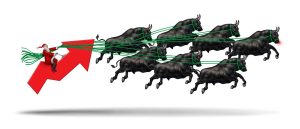By Jamie McGeever
ORLANDO, Florida (Reuters) – The U.S. high yield bond market is the dog that has rarely barked, never mind bitten, during the Federal Reserve’s most aggressive interest rate-raising campaign in 40 years.
The economy’s remarkable resilience to that monetary tightening, and cooling inflation, are the obvious explanations why spreads have remained well behaved. The ‘junk’ bond market may also contain less junk than it used to.
Many companies at the lower end of the credit rating spectrum are opting to raise finance in private markets rather than the more traditional route of issuance via public markets.
It is difficult to gather concrete figures on the flow of high yield issuers into the private space, or the credit quality breakdown of that flow. But changes in the composition of a leading high yield corporate bond index over recent years suggests this might be the case.
The average credit rating of the ICE BofA U.S. high yield corporate bond index over the last decade, on a weighted market value basis, has consistently been B1, according to ICE.
But there has been a lot of movement within that. The share of all BB-rated bonds in the index is notably higher than a decade ago, having shot up above 50% after the pandemic. The share of all C-rated bonds, conversely, is much lower, below 11%.
Meanwhile, the share of bonds with a B1 rating, the index average, is the highest in nearly a decade at almost 16%.
Non-investment grade or ‘junk’ bonds’ credit ratings are Ba1/BB+ or lower.
There were 1,854 bonds in the index at the end of October, ICE data shows, the lowest since the pandemic. The number of bonds with any ‘C’ rating was 256, the lowest in at least a decade and almost half the total of 474 at the end of 2013.
“The high yield index is a higher quality index than in cycles past,” reckons Bill Callahan, investment strategist at Schroders (LON:). “A lot of lower quality issuers have moved to other ways of getting access to financing capital markets, like private credit and bank loans.”
COMFORT BLANKET
Like the inverted yield curve, a sharp widening of junk bond spreads over Treasuries may not be the reliable warning of an incoming economic and financial market storm it once was.
Even at the height of the U.S. regional banking shock in March this year, the high yield spread barely reached 500 basis points before quickly compressing. It is now below 400 bps, and high yield bond investors are the most overweight since January, BofA’s latest survey shows.
The rise in borrowing costs this year as the Fed has lifted interest rates to a 5.25-5.50% range is such that it now offers bond investors a pretty cozy safety blanket against further price declines.
Analysts at Schroders reckon high yield corporate debt yields would have to rise by almost 250 bps before bond holders would feel the capital hit. That would mean U.S. junk bond yields rising to around 11-12%.
It’s not impossible, but would probably require a recession or fear of recession for it to pan out. Bank of America’s high yield strategists recommend leaning against the ‘perfect soft landing’ narrative gathering momentum in financial markets, and lay out such a scenario that could play out next year.
When rate cuts are imminent or underway with the economy near or in recession, spreads will widen to 800 bps and the will plunge to 2.5%. That would imply a nominal yield on non-investment grade bonds of around 10.5%.
That’s approximately the level weaker non-investment grade companies are borrowing in the private credit space, experts say, noting a fairly standard overnight rate plus 600 basis points.
Growth in the private credit market is explosive. Alternative investment data provider Preqin estimate that assets under management quadrupled to $1.6 trillion early this year from $437 billion a decade ago, and virtually doubled from $831 billion in 2019.
If a chunk of that growth is from lower credit-quality companies entering the space, pressure on public markets may, on the margin, be easing.
However, Ashwin Krishnan, managing director and co-head of North America private credit at Morgan Stanley, is skeptical that the recent tightening in junk bond spreads in public markets is related to flows into private credit.
“The economy has been resilient and inflation data has generally been good. This has caused prices to reconsider their choppy trajectory from earlier in the year,” he says.
(The opinions expressed here are those of the author, a columnist for Reuters.)
Read the full article here














